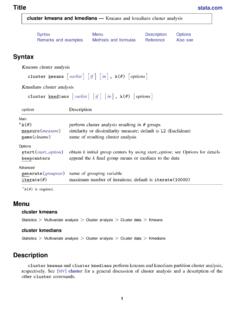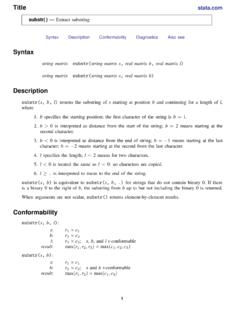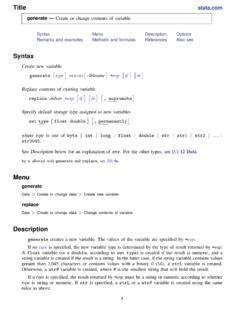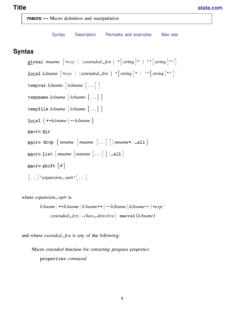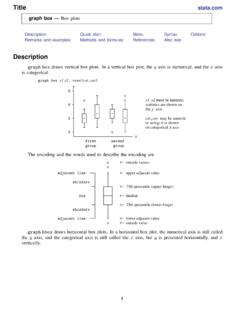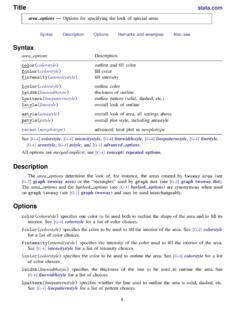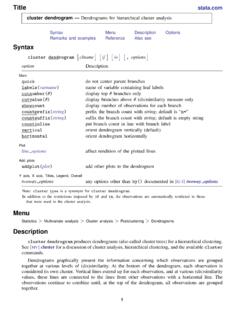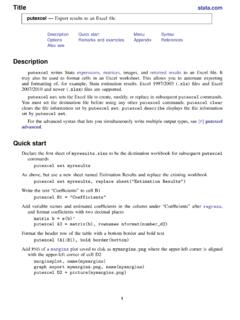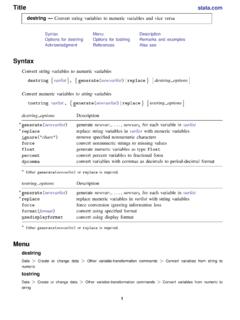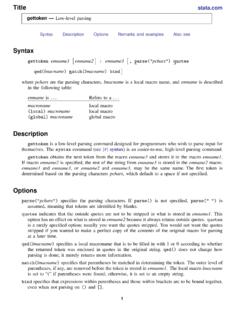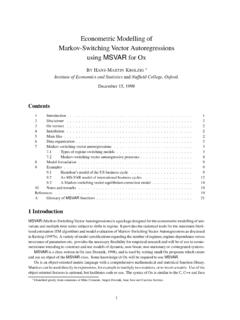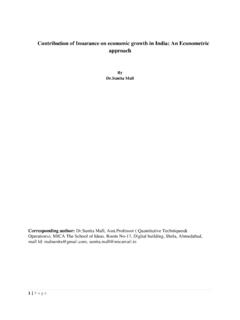Transcription of forecast — Econometric model forecasting
1 Econometric model forecastingSyntaxDescriptionRemarks and examplesReferencesAlso [,options]subcommandDescriptioncreatecre ate a new modelestimatesadd estimation result to current modelidentityspecify an identity (nonstochastic equation)coefvectorspecify an equation via a coefficient vectorexogenousdeclare exogenous variablessolveobtain one-step-ahead or dynamic forecastsadjustadjust a variable by add factoring, replacing, a modellistlist allforecastcommands composing current modelclearclear current model from memorydropdrop forecast variablesquerycheck whether a forecast model has been startedSee [TS] forecast create, [TS] forecast estimates, [TS] forecast identity, [TS] forecast coefvector,[TS] forecast exogenous, [TS] forecast solve, [TS] forecast adjust, [TS] forecast describe,[TS] forecast list, [TS] forecast clear, [TS] forecast drop, and [TS] forecast queryfor details aboutthese a suite of commands for obtaining forecasts by solving models, collections ofequations that jointly determine the outcomes of one or more variables.
2 Equations can be stochasticrelationships fit using estimation commands such asregress,ivregress,var, orreg3; or they canbe nonstochastic relationships, called identities, that express one variable as a deterministic functionof other variables. forecasting models may also include exogenous variables whose values are alreadyknown or determined by factors outside the purview of the system being examined. Theforecastcommands can also be used to obtain dynamic forecasts in single-equation lets you incorporate outside information into your forecasts through the useof add factors and similar devices, and you can specify the future path for some model variablesand obtain forecasts for other variables conditional on that path. Each set of forecast variables has itsown name prefix or suffix, so you can compare forecasts based on alternative scenarios.
3 Confidenceintervals for forecasts can be obtained via stochastic simulation and can incorporate both parameteruncertainty and additive error with both time-series and panel datasets. Time-series datasets may not containany gaps, and panel datasets must be strongly forecast Econometric model forecastingThis manual entry provides an overview of forecasting models and several examples showing howtheforecastcommands are used together. See the individual subcommands manual entries fordetailed discussions of the various options available and specific remarks about those and forecasting model is a system of equations that jointly determine the outcomes of one or moreendogenous variables, whereby the termendogenousvariables contrasts withexogenousvariables,whose values are not determined by the interplay of the system s equations.
4 A model , in the contextof theforecastcommands, consists of1. zero or more stochastic equations fit using Stata estimation commands and added to thecurrent model usingforecast estimates. These stochastic equations describe the behaviorof endogenous zero or more nonstochastic equations (identities) defined usingforecast identity. Theseequations often describe the behavior of endogenous variables that are based on accountingidentities or adding-up zero or more equations stored as coefficient vectors and added to the current model usingforecast coefvector. Typically, you will fit your equations in Stata and useforecastestimatesto add them to the coefvectoris used to add equationsobtained zero or more exogenous variables declared usingforecast at least one stochastic equation or optional adjustments to be made to the variables of the model declared usingforecast use of adjustments is to produce forecasts under alternative are designed to be easy to use, so without further ado, we dive headfirstinto an 1: Klein s modelExample 3 of [R]reg3shows how to fit Klein s (1950) model of the economy using thethree-stage least-squares estimator (3 SLS).
5 Here we focus on how to make forecasts from that modelonce the parameters have been estimated. In Klein s model , there are seven equations that describethe seven endogenous variables. Three of those equations are stochastic relationships, while the restare identities:ct= 0+ 1pt+ 2pt 1+ 3wt+ 1t(1)it= 4+ 5pt+ 6pt 1+ 7kt 1+ 2t(2)wpt= 8+ 9yt+ 10yt 1+ 11yrt+ 3t(3)yt=ct+it+gt(4)pt=yt tt wpt(5)kt=kt 1+it(6)wt=wgt+wpt(7) forecast Econometric model forecasting 3 The variables in the model are defined as follows:NameDescriptionTypecConsumptione ndogenouspPrivate-sector profitsendogenouswpPrivate-sector wagesendogenouswgGovernment-sector wagesexogenouswTotal wagesendogenousiInvestmentendogenouskCap ital stockendogenousyNational incomeendogenousgGovernment spendingexogenoustIndirect bus. taxes+net exportsexogenousyrTime trend=Year 1931exogenousOur model has four exogenous variables: government-sector wages (wg), government spending (g),a time-trend variable (yr), and, for simplicity, a variable that lumps indirect business taxes and netexports together (t).
6 To make out-of-sample forecasts, we must populate those variables over theentire forecast horizon before solving our model . (We use the phrases solve our model and obtainforecasts from our model interchangeably.)We will illustrate the entire process of fitting and forecasting our model , though our focus will beon the latter task. See [R]reg3for a more in-depth look at fitting models like this one. Before wesolve our model , we first estimate the parameters of the stochastic equations by loading the datasetand callingreg3:4 forecast Econometric model forecasting . use reg3 (c p w) (i p ) (wp y yr), endog(w p y) exog(t wg g)Three-stage least-squares regressionEquation Obs Parms RMSE "R-sq" chi2 Pc 21 3 .9443305 21 3 21 3.
7 7211282 Std. Err. z P>|z| [95% Conf. Interval] .1081291 ..1004382 ..0379379 .715724 ..1618962 ..1529331 .4559805 .0325307 .0318134 .3381388 ..0341588 .1143411 ..0279352 .094922 . variables: c i wp w p yExogenous variables: yr t wg gThe output fromreg3indicates that we have a total of six endogenous variables even though ourmodel in fact has seven. The discrepancy stems from (6) of our model . The capital stock variable (k)is a function of the endogenous investment variable and is therefore itself endogenous. However,ktdoes not appear in any of our model s stochastic equations, so we did not declare it in theendog()option ofreg3; from a purely estimation perspective, the contemporaneous value of the capital stockvariable is irrelevant, though it does play a role in terms of solving our model .
8 We next store theestimation results usingestimates store:. estimates store kleinNow we are ready to define our model using theforecastcommands. We first tell Stata toinitialize a new model ; we will call our modelkleinmodel:. forecast create kleinmodelForecast model kleinmodel Econometric model forecasting 5 The name you give the model mainly controls how output fromforecastcommands is importantly, forecast createcreates the internal data structures Stata uses to keep track ofyour next step is to add all the equations to the model . To add the three stochastic equations wefit usingreg3, we useforecast estimates:. forecast estimates kleinAdded estimation results model kleinmodel now contains 3 endogenous command tells Stata to find the estimates stored askleinand add them to our those estimation results to determine that there are three endogenous variables (c,i,andwp), and it will save the estimated parameters and other information thatforecast solvewilllater need to obtain predictions for those estimatesconfirmed our request byreporting that the estimation results added were estimatesreports that our forecast model has three endogenous variables because ourreg3command included three left-hand-side variables.
9 The fact that we specified three additionalendogenous variables in theendog()option ofreg3so thatreg3reports a total of six endogenousvariables is irrelevant toforecast. All that matters is the number of left-hand-side variables in also need to specify the four identities, equations (4) through (7), that determine the other fourendogenous variables in our model . To do that, we useforecast identity:. forecast identity y = c + i + gForecast model kleinmodel now contains 4 endogenous forecast identity p = y - t - wpForecast model kleinmodel now contains 5 endogenous forecast identity k = + iForecast model kleinmodel now contains 6 endogenous forecast identity w = wg + wpForecast model kleinmodel now contains 7 endogenous specify identities similarly to how you use thegeneratecommand, except that the left-hand-sidevariable is an endogenous variable in your model rather than a new variable you want to create in yourdataset.
10 Time-series operators often come in handy when specifying identities; here we expressedcapital, a stock variable, as its previous value plus current-period investment, a flow variable. Anidentity defines an endogenous variable, so each time we useforecast identity, the number ofendogenous variables in our forecast model increases by , we will tell Stata about the four exogenous variables. We do that with theforecastexogenouscommand:. forecast exogenous wgForecast model kleinmodel now contains 1 declared exogenous forecast exogenous gForecast model kleinmodel now contains 2 declared exogenous forecast exogenous tForecast model kleinmodel now contains 3 declared exogenous forecast exogenous yrForecast model kleinmodel now contains 4 declared exogenous track of the exogenous variables that you declare using theforecast exogenouscommand and reports the number currently in the model .
